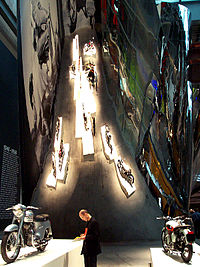Art of the Motorcycle
| Subject: | motorcycles |
|---|---|
| Nation/culture: | US and other industrialized countries. |
| Media: | motorcycles, film, speeches, memorabilia |
| Period: | 20th century |
| Host: | Solomon R. Guggenheim Museum, New York, NY |
| Major lenders: | Barber Vintage Motorsports Museum,Chandler Vintage Museum of Transportation and Wildlife |
| Financial sponsors: | BMW, Lufthansa |
| Opening Venue: | Solomon R. Guggenheim Museum, New York, NY June 26, 1998 - September 20, 1998 |
| Second Venue: | Field Museum of Natural History, Chicago, IL November 7, 1998 - March 21, 1999 |
| Third Venue: | Guggenheim Museum Bilbao, Spain November 24, 1999 - September 3, 2000 |
| Final Venue*: | Guggenheim Las Vegas, NV October 7, 2001 - January 6, 2003 |
| Total attendance: | 2,000,000 |
| Curators | Thomas Krens, Charles Falco, Ultan Guilfoyle |
| * Later derivative exhibitions licensing the name were put on by Wonders: The Memphis International Cultural Series and the Orlando Museum of Art, and others, using some of the original catalog and a variety of interior designs, but not curated by the Guggenheim. | |
The Art of the Motorcycle was an exhibition that presented 114 motorcycles chosen for their historic importance or design excellence in a display designed by Frank Gehry in the curved rotunda of the Frank Lloyd Wright-designed Solomon R. Guggenheim Museum in New York City, running for three months in late 1998. The exhibition attracted the largest crowds ever at that museum, and received mixed but positive reviews in the art world, with the exception of some art and social critics who rejected outright the existence of such a show at an institution like the Guggenheim, condemning it for excessive populism, and for being compromised by the financial influence of its sponsors.
The unusual move to place motorcycles in the Guggenheim came from director Thomas Krens, himself a motorcycling enthusiast, supported by a novel corporate tie-in with BMW. The motorcycles were chosen by experts including Krens, physicist and motorcycling historian Charles Falco, Guggenheim advisers Ultan Guilfoyle and Manon Slone, and others. The exhibition was described by historian Jeremy Packer as representing the end of a cycle of demonization and social rejection of motorcyclists, followed by acceptance and reintegration that had begun with the mythologized Hollister riot of 1947 and ended with the high-end marketing of motorcycles and the newly fashionable biker image of the 1980s and 1990s. Or at least the show served as "a long-overdue celebration of the sport, the machines and the pioneers they love."
The exhibition was the beginning of a new trend in profitable, blockbuster museum exhibits, foreshadowed by The Treasures of Tutankhamun tour of 1972-1979. Questions over the museum's relationship with corporate financial sponsors, both in this show and the tribute to the work of fashion designer Giorgio Armani (on the heels of a $15 million pledge to the museum from Mr. Armani) that followed shortly after, contributed to soul searching and the drafting of new ethical guidelines by the Association of Art Museum Directors.
...
Wikipedia

